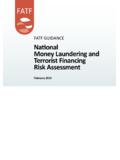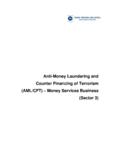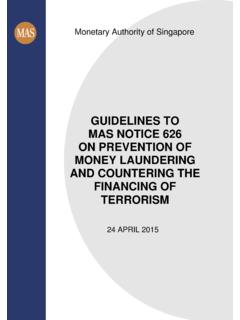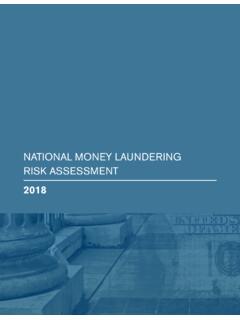Transcription of Laundering the proceeds of corruption - FATF-GAFI.ORG
1 Financial Action Task Force Groupe d action financi re Laundering the proceeds of corruption July 2011 FATF Report THE FINANCIAL ACTION TASK FORCE (FATF) The Financial Action Task Force (FATF) is an independent inter-governmental body that develops and promotes policies to protect the global financial system against money Laundering and terrorist financing. Recommendations issued by the FATF define criminal justice and regulatory measures that should be implemented to counter this problem. These Recommendations also include international co-operation and preventive measures to be taken by financial institutions and others such as casinos, real estate dealers, lawyers and accountants. The FATF Recommendations are recognised as the global anti-money Laundering (AML) and counter-terrorist financing (CFT) standard. For more information about the FATF, please visit the website: 2011 FATF/OECD.
2 All rights reserved Cover image Thinkstock No reproduction or translation of this publication may be made without prior written permission. Applications for such permission, for all or part of this publication, should be made to the FATF Secretariat, 2 rue Andr Pascal 75775 Paris Cedex 16, France (fax +33 1 44 30 61 37 or e-mail: Laundering the proceeds of corruption July 2011 2011 FATF/OECD - 3 TABLE OF CONTENTS 1. INTRODUCTION .. 4 Scope .. 6 Methodology .. 7 2. WHY A TYPOLOGY ON Laundering THE proceeds OF corruption ? .. 9 A. corruption and the economy .. 9 B. Recent attention on corruption .. 11 C. Other initiatives and studies analyzing and reviewing the investigation and prosecution of 12 1. The global anticorruption framework .. 12 2. Other studies .. 15 3. AN ANALYSIS OF THE MOST COMMON METHODS USED TO LAUNDER THE proceeds OF GRAND corruption .. 16 A. Use of Corporate Vehicles and Trusts .. 17 B.)
3 Use of Gatekeepers .. 19 C. Use of Domestic Financial Institutions .. 21 D. Use of Offshore/Foreign Jurisdictions .. 23 E. Use of Nominees .. 23 F. Use of 24 4. VULNERABILITIES LEADING TO AN INCREASED RISK OF THE Laundering OF THE proceeds OF corruption .. 26 A. Control over the State .. 26 B. Financial Institution Capture .. 28 C. Ineffective Enhanced Due Diligence .. 29 D. Ineffective communication among States and financial institutions .. 32 5. CONCLUSION .. 34 6. SUGGESTED FOLLOW-UP WORK .. 35 REFERENCES .. 38 BIBLIOGRAPHY .. 42 ANNEXES .. 46 ANNEX 1: GRAND corruption CASE INVENTORY .. 47 ANNEX 2: OVERVIEW OF INTERNATIONAL ACTION TO FREEZE ASSETS BELONGING TO FORMER HEADS OF STATE, THEIR ENTOURAGE AND CERTAIN STATE ENTITIES UNDER THEIR CONTROL .. 51 Laundering the proceeds of corruption July 2011 4 - 2011 FATF/OECD Laundering the proceeds of corruption July 2011 2011 FATF/OECD - 5 Laundering the proceeds of corruption July 2011 6 - 2011 FATF/OECD 1.
4 INTRODUCTION 1. This typology originates from a practitioners understanding that the fight against corruption is inextricably intertwined with that against money Laundering ; that the stolen assets of a corrupt public official are useless unless they are placed, layered, and integrated into the global financial network in a manner that does not raise suspicion. In some ways, a public official (known as a politically exposed person, or PEP )1 who gathers vast sums of money through corrupt means is far more vulnerable than some other criminals. A narcotics trafficker may reliably depend on being able to remain anonymous with his vast amount of money; a public official begins to draw unwanted attention as soon as he is associated with significant sums from unknown sources. Thus, the corrupt PEP s vulnerability presents an opportunity for those authorities engaged in both anti-money Laundering /combating the financing of terrorism (AML/CFT) and anti- corruption (AC) enforcement.
5 2. This typology differs from other such typologies previously produced by the Financial Action Task Force (FATF) because it draws from publicly available work undertaken by experts. The body of work the project team analyzed represents deep AML expertise possessed by individuals and organisations around the globe. Indeed, the objective was to understand these works to draw conclusions from them. Broadly stated, the goal was to stand on the shoulders of others in order to better understand corruption , its mechanisms and vulnerabilities, through an AML/CFT lens. Scope 3. Part of the mandate of the Working Group on Typologies (WGTYP) is to identify new threats and vulnerabilities and conduct research on money Laundering and terrorist financing methods and techniques. FATF typology reports typically reveal, describe, and explain the nature of ML/TF methods and threats, thus increasing global awareness and opportunities for earlier detection.
6 In light of its mandate, the project team focused only on the methods used to launder the proceeds of corruption . It does not attempt to describe the methods by which bribery and other corruption are effectuated, concealed, or discovered; such a discussion would be outside of the scope of this paper. 4. While there may be no internationally recognised legal definition of corruption , it is most commonly functionally defined as the use of public office for private gain. The United Nations,2 the Organisation for Economic Co-Operation and Development (OECD),3 and the Council of Europe4 Conventions establish the offences for a range of corrupt behaviour. The conventions define 1 The Glossary to the FATF 40+9 Recommendations describe PEPs as individuals who are or have been entrusted with prominent public functions in a foreign country, for example heads of state, or of government, senior politicians, senior government, judicial or military officials, senior executives of state owned corporations [and] important political party officials.
7 The definition is not intended to cover middle ranking or more junior individuals in the foregoing categories. 2 United Nations (2004) 3 OECD (1997) 4 Council of Europe (1999) Laundering the proceeds of corruption July 2011 2011 FATF/OECD - 7 international standards on the criminalisation of corruption by prescribing specific offences rather than through a generic definition or offense of The offenses can range from petty or systemic corruption , in which public officials or employees receive money to perform (or refrain from performing) official acts, to grand corruption , in which those at the political, decision-making levels of government use their office to enrich themselves, their families, and their 5. Because of time and resource limitations involved in this project, the project team restricted itself to an analysis of grand corruption . While there is no precise threshold -- by official rank or otherwise -- to distinguish grand from systemic corruption , the positions of the PEPs involved in the cases in our report ranged from senior legislators to governors to prime ministers and presidents.
8 All of the cases examined involved behaviour that would constitute offenses falling under any of the relevant international AC conventions, as well as the generic definition described above. Where possible, the case studies identified the type of corrupt act from which the proceeds had been derived. The types of corruption involved bribe taking and kickbacks, of both foreign and domestic officials, but also embezzlement (in which money rightly belonging to the State was siphoned for personal use through a variety of means), extortion (in which the public official uses the threat of official power to receive money) and self dealing (in which the corrupt PEP has a personal financial interest in acts and decisions he makes in his official capacity). Methodology 6. In conducting the analysis, the project team relied on case descriptions and analyses conducted by others. The touchstone in determining whether to include a case in this report was reliability.
9 To assess this, the team considered the author of the analysis, the source of information, the availability of source documents, and finally, the purpose for which the analysis was conducted. Court opinions making factual findings on the details of a specific scheme, for example, were deemed to be highly reliable, as were documents prepared by law enforcement based on investigations. The project team also used case descriptions that clearly relied on firsthand source documents, such as some government reports and asset recovery lawsuits. As with other FATF typologies, a criminal conviction or official finding of culpability was not a requirement for inclusion, although in the vast majority of cases in the study that was the case. The purpose of including a case was not to draw conclusions about the culpability of the individuals involved; rather, it was to draw conclusions about the probable methods for Laundering the proceeds of corruption .
10 7. The project team compiled the data according to those involved, including the countries involved, the level of the PEP, and the nature of the corrupt act. For every case, the project team looked for the presence of methods generally used for the Laundering of money, such as corporate vehicles (a category considered to include shell companies and trusts), foreign financial institutions, a financial institution that had been compromised or captured by a PEP by gaining ownership or management control over it, or the use of nominees, close associates, family members, or the use of false identities. The team also gathered data on the role of gatekeepers lawyers, accountants, corporate formation agents, and the like in furthering these schemes. Lastly, the team looked to 5 OECD (2008) 6 U4, the anticorruption resource centre sponsored by a number of governments, defines grand corruption as that taking place at the policy formulation end of politics.



















